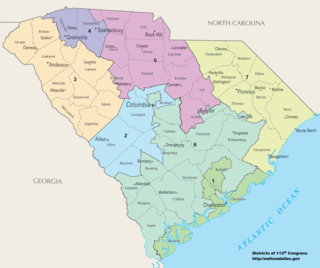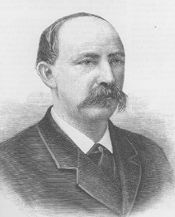
South Carolina is a state in the coastal Southeastern region of the United States. It is bordered to the north by North Carolina, to the southeast by the Atlantic Ocean, and to the southwest by Georgia across the Savannah River. South Carolina is the 40th most extensive and 23rd most populous U.S. state with a recorded population of 5,124,712 according to the 2020 census. In 2019, its GDP was $213.45 billion. South Carolina is composed of 46 counties. The capital is Columbia with a population of 137,300 in 2020; while its largest city is Charleston with a 2020 population of 150,277. The Greenville–Spartanburg-Anderson metropolitan area is the most populous in the state, with a 2020 population estimate of 1,455,892.

Orangeburg, also known as The Garden City, is the principal city in and the county seat of Orangeburg County, South Carolina, United States. The population of the city was 13,964 according to the 2010 United States Census and declined to 12,704 in the 2020 census. The city is located 37 miles southeast of Columbia, on the north fork of the Edisto River.

Spartanburg is a city in and the seat of Spartanburg County, South Carolina, United States. The city of Spartanburg has a municipal population of 38,732 as of the 2020 Census, making it the 11th-largest city in the state. For a time, the Office of Management and Budget (OMB) grouped Spartanburg and Union Counties together as the Spartanburg metropolitan statistical area, but as of 2018,the OMB defines only Spartanburg County as the Spartanburg MSA.

The African Methodist Episcopal Church, usually called the AME Church or AME, is a predominantly African American Methodist denomination. It adheres to Wesleyan-Arminian theology and has a connexional polity. The African Methodist Episcopal Church is the first independent Protestant denomination to be founded by Black people; though it welcomes and has members of all ethnicities.
Columbia College is a private liberal arts college in Columbia, South Carolina. Founded in 1854 by the United Methodist Church as a women's liberal arts college, Columbia College became fully coeducational in 2020 welcoming its first coed residential class in Fall 2021. It also offers evening, graduate, and online programs for women and men.

U.S. Route 176 is a spur of US 76 in the U.S. states of North Carolina and South Carolina. The U.S. Highway runs 237.98 miles (382.99 km) from US 25 Business and North Carolina Highway 225 in Hendersonville, North Carolina, east to US 52 in Goose Creek, South Carolina. US 176 serves the transition region between the Blue Ridge Mountains and Foothills of Western North Carolina and the Upstate, Midlands, and Lowcountry regions of South Carolina. The highway passes through and connects Spartanburg, one of two major cities in the Upstate, and Columbia, the South Carolina state capital and central city of the Midlands. US 176 parallels and serves as a secondary highway to Interstate 26 (I-26) except for between Spartanburg and Columbia, where the U.S. Highway deviates from the I-26 corridor to serve Union.

Wofford College is a private liberal arts college in Spartanburg, South Carolina. It was founded in 1854. The 175-acre (71 ha) campus is a national arboretum and one of the few four-year institutions in the southeastern United States founded before the American Civil War that still operates on its original campus.
The Southern Methodist Church is a conservative Protestant Christian denomination with churches located in the southern part of the United States. The church maintains headquarters in Orangeburg, South Carolina.

The North Carolina Conference is an Annual Conference of the United Methodist Church. This conference serves the eastern half of the state of North Carolina, with its administrative offices and the office of the bishop located in Garner, North Carolina. It is part of the Southeastern Jurisdictional Conference. The current bishop of the North Carolina Conference is the Reverend Hope Morgan Ward.

There are currently seven United States congressional districts in South Carolina. There have been as few as four and as many as nine congressional districts in South Carolina. The 9th district and the 8th district were lost after the 1840 Census. Because the state exceeded the nation's average population growth in the 2010 Census, South Carolina regained its 7th district, which had remained unused since the Civil War.

The Western North Carolina Conference is an Annual Conference of the United Methodist Church. This conference serves the western half of the state of North Carolina, with its administrative offices and the office of the bishop being located in Huntersville, North Carolina. It is part of the Southeastern Jurisdictional Conference.

Spartanburg Methodist College is a private Methodist college in Saxon, South Carolina, with a Spartanburg postal address. The college serves approximately 1,000 students. The college awards six associate degrees, a unique customizable bachelor’s degree with six concentrations, a bachelor’s degree in business administration, and nine 100% online associate and bachelor’s degree programs.

Samuel Dibble was a lawyer, educator and U.S. Representative from South Carolina.
Gloria Blackwell, also known as Gloria Rackley, was an African-American civil rights activist and educator. She was at the center of the Civil Rights Movement in Orangeburg, South Carolina during the 1960s, attracting some national attention and a visit by Dr. Martin Luther King of the Southern Christian Leadership Conference. Her activities were widely covered by the local press.

Edward Culliatt Jones was an American architect from Charleston, South Carolina. A number of his works are listed on the U.S. National Register of Historic Places, and two are further designated as U.S. National Historic Landmarks. His works include the following :

Lizelia Augusta Jenkins Moorer was a poet and teacher in Orangeburg, South Carolina.












